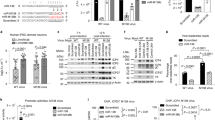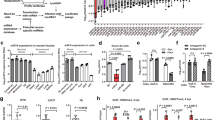Abstract
Herpesviruses are characterized by their ability to maintain life-long latent infections in their animal hosts. However, the mechanisms that allow establishment and maintenance of the latent state remain poorly understood. Herpes simplex virus 1 (HSV-1) establishes latency in neurons of sensory ganglia, where the only abundant viral gene product is a non-coding RNA, the latency associated transcript (LAT)1,2. Here we show that LAT functions as a primary microRNA (miRNA) precursor that encodes four distinct miRNAs in HSV-1 infected cells. One of these miRNAs, miR-H2-3p, is transcribed in an antisense orientation to ICP0—a viral immediate-early transcriptional activator that is important for productive HSV-1 replication and thought to have a role in reactivation from latency3. We show that miR-H2-3p is able to reduce ICP0 protein expression, but does not significantly affect ICP0 messenger RNA levels. We also identified a fifth HSV-1 miRNA in latently infected trigeminal ganglia, miR-H6, which derives from a previously unknown transcript distinct from LAT. miR-H6 shows extended seed complementarity to the mRNA encoding a second HSV-1 transcription factor, ICP4, and inhibits expression of ICP4, which is required for expression of most HSV-1 genes during productive infection4. These results may explain the reported ability of LAT to promote latency5,6,7,8,9. Thus, HSV-1 expresses at least two primary miRNA precursors in latently infected neurons that may facilitate the establishment and maintenance of viral latency by post-transcriptionally regulating viral gene expression.
This is a preview of subscription content, access via your institution
Access options
Subscribe to this journal
Receive 51 print issues and online access
$199.00 per year
only $3.90 per issue
Buy this article
- Purchase on Springer Link
- Instant access to full article PDF
Prices may be subject to local taxes which are calculated during checkout




Similar content being viewed by others
References
Bloom, D. C. HSV LAT and neuronal survival. Int. Rev. Immunol. 23, 187–198 (2004)
Stevens, J. G., Wagner, E. K., Devi-Rao, G. B., Cook, M. L. & Feldman, L. T. RNA complementary to a herpesvirus alpha gene mRNA is prominent in latently infected neurons. Science 235, 1056–1059 (1987)
Everett, R. D. ICP0, a regulator of herpes simplex virus during lytic and latent infection. Bioessays 22, 761–770 (2000)
Preston, C. M. Control of herpes simplex virus type 1 mRNA synthesis in cells infected with wild-type virus or the temperature-sensitive mutant tsK . J. Virol. 29, 275–284 (1979)
Chen, S. H., Kramer, M. F., Schaffer, P. A. & Coen, D. M. A viral function represses accumulation of transcripts from productive-cycle genes in mouse ganglia latently infected with herpes simplex virus. J. Virol. 71, 5878–5884 (1997)
Garber, D. A., Schaffer, P. A. & Knipe, D. M. A LAT-associated function reduces productive-cycle gene expression during acute infection of murine sensory neurons with herpes simplex virus type 1. J. Virol. 71, 5885–5893 (1997)
Thompson, R. L. & Sawtell, N. M. Herpes simplex virus type 1 latency-associated transcript gene promotes neuronal survival. J. Virol. 75, 6660–6675 (2001)
Thompson, R. L. & Sawtell, N. M. The herpes simplex virus type 1 latency-associated transcript gene regulates the establishment of latency. J. Virol. 71, 5432–5440 (1997)
Sawtell, N. M. & Thompson, R. L. Herpes simplex virus type 1 latency-associated transcription unit promotes anatomical site-dependent establishment and reactivation from latency. J. Virol. 66, 2157–2169 (1992)
Farrell, M. J., Dobson, A. T. & Feldman, L. T. Herpes simplex virus latency-associated transcript is a stable intron. Proc. Natl Acad. Sci. USA 88, 790–794 (1991)
Kang, W. et al. Characterization of a spliced exon product of herpes simplex type-1 latency-associated transcript in productively infected cells. Virology 356, 106–114 (2006)
Bartel, D. P. MicroRNAs: genomics, biogenesis, mechanism, and function. Cell 116, 281–297 (2004)
Hafner, M. et al. Identification of microRNAs and other small regulatory RNAs using cDNA library sequencing. Methods 44, 3–12 (2008)
Perng, G. C. et al. A novel herpes simplex virus type 1 transcript (AL-RNA) antisense to the 5′ end of the latency-associated transcript produces a protein in infected rabbits. J. Virol. 76, 8003–8010 (2002)
Cui, C. et al. Prediction and identification of herpes simplex virus 1-encoded microRNAs. J. Virol. 80, 5499–5508 (2006)
Dölken, L. et al. Mouse cytomegalovirus microRNAs dominate the cellular small RNA profile during lytic infection and show features of posttranscriptional regulation. J. Virol. 81, 13771–13782 (2007)
Feldman, L. T. et al. Spontaneous molecular reactivation of herpes simplex virus type 1 latency in mice. Proc. Natl Acad. Sci. USA 99, 978–983 (2002)
Sawtell, N. M. Comprehensive quantification of herpes simplex virus latency at the single-cell level. J. Virol. 71, 5423–5431 (1997)
Gupta, A., Gartner, J. J., Sethupathy, P., Hatzigeorgiou, A. G. & Fraser, N. W. Anti-apoptotic function of a microRNA encoded by the HSV-1 latency-associated transcript. Nature 442, 82–85 (2006)
Cai, W. et al. The herpes simplex virus type 1 regulatory protein ICP0 enhances virus replication during acute infection and reactivation from latency. J. Virol. 67, 7501–7512 (1993)
Halford, W. P., Kemp, C. D., Isler, J. A., Davido, D. J. & Schaffer, P. A. ICP0, ICP4, or VP16 expressed from adenovirus vectors induces reactivation of latent herpes simplex virus type 1 in primary cultures of latently infected trigeminal ganglion cells. J. Virol. 75, 6143–6153 (2001)
Chen, S. H. et al. Neither LAT nor open reading frame P mutations increase expression of spliced or intron-containing ICP0 transcripts in mouse ganglia latently infected with herpes simplex virus. J. Virol. 76, 4764–4772 (2002)
Thompson, R. L., Shieh, M. T. & Sawtell, N. M. Analysis of herpes simplex virus ICP0 promoter function in sensory neurons during acute infection, establishment of latency, and reactivation in vivo . J. Virol. 77, 12319–12330 (2003)
Pfeffer, S. et al. Identification of virus-encoded microRNAs. Science 304, 734–736 (2004)
Yeh, L. & Schaffer, P. A. A novel class of transcripts expressed with late kinetics in the absence of ICP4 spans the junction between the long and short segments of the herpes simplex virus type 1 genome. J. Virol. 67, 7373–7382 (1993)
Randall, G. & Roizman, B. Transcription of the derepressed open reading frame P of herpes simplex virus 1 precludes the expression of the antisense γ134.5 gene and may account for the attenuation of the mutant virus. J. Virol. 71, 7750–7757 (1997)
Lee, L. Y. & Schaffer, P. A. A virus with a mutation in the ICP4-binding site in the L/ST promoter of herpes simplex virus type 1, but not a virus with a mutation in open reading frame P, exhibits cell-type-specific expression of γ134.5 transcripts and latency-associated transcripts. J. Virol. 72, 4250–4264 (1998)
Murphy, E., Vanicek, J., Robins, H., Shenk, T. & Levine, A. J. Suppression of immediate-early viral gene expression by herpesvirus-coded microRNAs: implications for latency. Proc. Natl Acad. Sci. USA 105, 5453–5458 (2008)
Coen, D. M., Fleming, H. E., Leslie, L. K. & Retondo, M. J. Sensitivity of arabinosyladenine-resistant mutants of herpes simplex virus to other antiviral drugs and mapping of drug hypersensitivity mutations to the DNA polymerase locus. J. Virol. 53, 477–488 (1985)
Goldin, A. L., Sandri-Goldin, R. M., Levine, M. & Glorioso, J. C. Cloning of herpes simplex virus type 1 sequences representing the whole genome. J. Virol. 38, 50–58 (1981)
Sekulovich, R. E., Leary, K. & Sandri-Goldin, R. M. The herpes simplex virus type 1 α protein ICP27 can act as a trans-repressor or a trans-activator in combination with ICP4 and ICP0. J. Virol. 62, 4510–4522 (1988)
Brummelkamp, T. R., Bernards, R. & Agami, R. A system for stable expression of short interfering RNAs in mammalian cells. Science 296, 550–553 (2002)
Wiegand, H. L., Doehle, B. P., Bogerd, H. P. & Cullen, B. R. A second human antiretroviral factor, APOBEC3F, is suppressed by the HIV-1 and HIV-2 Vif proteins. EMBO J. 23, 2451–2458 (2004)
Cai, X. et al. Kaposi’s sarcoma-associated herpesvirus expresses an array of viral microRNAs in latently infected cells. Proc. Natl Acad. Sci. USA 102, 5570–5575 (2005)
Alvira, M. R., Goins, W. F., Cohen, J. B. & Glorioso, J. C. Genetic studies exposing the splicing events involved in herpes simplex virus type 1 latency-associated transcript production during lytic and latent infection. J. Virol. 73, 3866–3876 (1999)
Leib, D. A. et al. Immediate-early regulatory gene mutants define different stages in the establishment and reactivation of herpes simplex virus latency. J. Virol. 63, 759–768 (1989)
Chen, C. et al. Real-time quantification of microRNAs by stem-loop RT-PCR. Nucleic Acids Res. 33, e179 (2005)
Acknowledgements
We thank R. Sandri-Goldin for reagents used in this research and S. Boissel for contributions to PCR primer design. This work was supported by National Institutes of Health grants to B.R.C. and D.M.C.
Author information
Authors and Affiliations
Corresponding author
Supplementary information
Supplementary Information
The file contains Supplementary Figures 1-3 with Legends and Supplementary Tables 1-6 and Legends. The figures show control data and additional experimental data in support of the manuscript’s conclusions. (PDF 631 kb)
Rights and permissions
About this article
Cite this article
Umbach, J., Kramer, M., Jurak, I. et al. MicroRNAs expressed by herpes simplex virus 1 during latent infection regulate viral mRNAs. Nature 454, 780–783 (2008). https://doi.org/10.1038/nature07103
Received:
Accepted:
Published:
Issue Date:
DOI: https://doi.org/10.1038/nature07103
This article is cited by
-
Neuronal miR-9 promotes HSV-1 epigenetic silencing and latency by repressing Oct-1 and Onecut family genes
Nature Communications (2024)
-
Endogenous and viral microRNAs in nasal secretions of water buffaloes (Bubalus bubalis) after Bubaline alphaherpesvirus 1 (BuHV-1) challenge infection
Veterinary Research (2023)
-
Intimate Relationship Between Stress and Human Alpha-Herpes Virus 1 (HSV-1) Reactivation from Latency
Current Clinical Microbiology Reports (2023)
-
HSV-1 latency-associated transcript miR-H3 and miR-H4 target STXBP1 and GABBR2 genes
Journal of NeuroVirology (2023)
-
Identification of herpesvirus transcripts from genomic regions around the replication origins
Scientific Reports (2023)
Comments
By submitting a comment you agree to abide by our Terms and Community Guidelines. If you find something abusive or that does not comply with our terms or guidelines please flag it as inappropriate.



